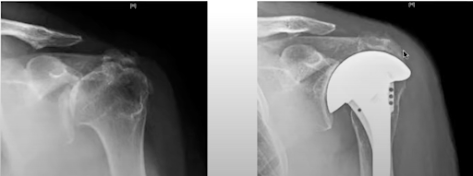A 71 year old active man presented with pain, stiffness and weakness of the right shoulder after prior rotator cuff surgery. He had active and passive elevation of his right arm to 90 degrees.
His radiographs are shown below
and Hamada 4B
No additional imaging was performed.
It is likely that managing this shoulder with a reverse total shoulder would have required the use of either a bone graft or an augmented baseplate as shown in the example below.
After a discussion of the alternatives, the patient elected to proceed with a CTA hemiarthroplasty. This was performed under general anesthesia without a nerve block.
At surgery the supraspinatus and infraspinatus tendons were retracted. The subscapularis was detached but reparable.
Three months after surgery he returned to the office for followup. He reported no shoulder discomfort and full active range of motion including the ability to reach up his back.
His x-ray at 3 months is shown below showing the fit of the extended articular surface CTA hemiarthroplasty head in to his "acetabulum" and the smooth standard length stem into the canal with impaction autografting.
You can support cutting edge shoulder research that is leading to better care for patients with shoulder problems, click on this link
Follow on twitter/X: https://x.com/RickMatsen
Follow on facebook: https://www.facebook.com/shoulder.arthritis
Follow on LinkedIn: https://www.linkedin.com/in/rick-matsen-88b1a8133/
Here are some videos that are of shoulder interest
Shoulder arthritis - what you need to know (see this link).
How to x-ray the shoulder (see this link).
The ream and run procedure (see this link).
The total shoulder arthroplasty (see this link).
The cuff tear arthropathy arthroplasty (see this link).
The reverse total shoulder arthroplasty (see this link).
The smooth and move procedure for irreparable rotator cuff tears (see this link).
Shoulder rehabilitation exercises (see this link).












